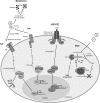Antiviral responses of arthropod vectors: an update on recent advances
- PMID: 25674592
- PMCID: PMC4188209
- DOI: 10.1007/s13337-014-0217-9
Antiviral responses of arthropod vectors: an update on recent advances
Abstract
Arthropod vectors, such as mosquitoes, ticks, biting midges and sand flies, transmit many viruses that can cause outbreaks of disease in humans and animals around the world. Arthropod vector species are invading new areas due to globalisation and environmental changes, and contact between exotic animal species, humans and arthropod vectors is increasing, bringing with it the regular emergence of new arboviruses. For future strategies to control arbovirus transmission, it is important to improve our understanding of virus-vector interactions. In the last decade knowledge of arthropod antiviral immunity has increased rapidly. RNAi has been proposed as the most important antiviral response in mosquitoes and it is likely to be the most important antiviral response in all arthropods. However, other newly-discovered antiviral strategies such as melanisation and the link between RNAi and the JAK/STAT pathway via the cytokine Vago have been characterised in the last few years. This review aims to summarise the most important and most recent advances made in arthropod antiviral immunity.
Keywords: Arbovirus; Innate immunity; Midge; Mosquito; RNAi; Tick.
Figures

References
-
- Asgari S. MicroRNA functions in insects. Insect Biochem Mol Biol. 2013;43:388–397. - PubMed
Publication types
LinkOut - more resources
Full Text Sources
Other Literature Sources

